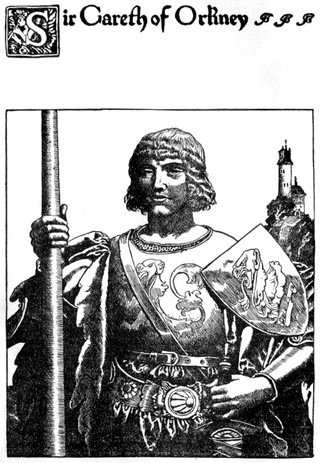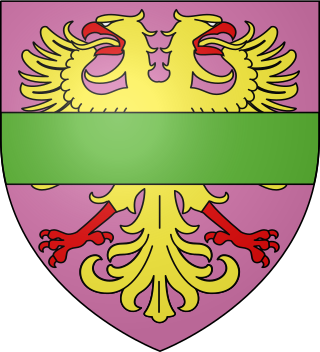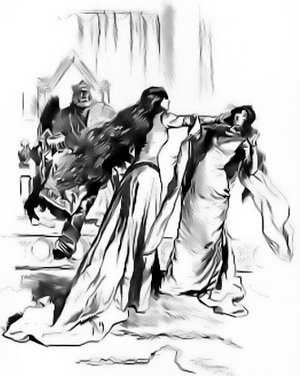
Guinevere, also often written in Modern English as Guenevere or Guenever, was, according to Arthurian legend, an early-medieval queen of Great Britain and the wife of King Arthur. First mentioned in popular literature in the early 12th century, nearly 700 years after the purported times of Arthur, Guinevere has since been portrayed as everything from a fatally flawed, villainous and opportunistic traitor to a noble and virtuous lady. Many records of the legend also feature the variably recounted story of her abduction and rescue as a major part of the tale.

Lancelot du Lac, also written as Launcelot and other variants, is a character in some versions of Arthurian legend where he is typically depicted as King Arthur's close companion and one of the greatest Knights of the Round Table. In the French-inspired Arthurian chivalric romance tradition, Lancelot is an orphaned son of King Ban of the lost kingdom of Benoic, raised in a fairy realm by the Lady of the Lake. A hero of many battles, quests and tournaments, and famed as a nearly unrivalled swordsman and jouster, Lancelot becomes the lord of the castle Joyous Gard and personal champion of Arthur's wife, Queen Guinevere, despite suffering from frequent and sometimes prolonged fits of madness. But when his adulterous affair with Guinevere is discovered, it causes a civil war that, once exploited by Mordred, brings an end to Arthur's kingdom.

Mordred or Modred is a figure in the legend of King Arthur. The earliest known mention of a possibly historical Medraut is in the Welsh chronicle Annales Cambriae, wherein he and Arthur are ambiguously associated with the Battle of Camlann in a brief entry for the year 537. Medraut's figure seemed to have been regarded positively in the early Welsh tradition and may have been related to that of Arthur's son.

The Knights of the Round Table are the legendary knights of the fellowship of King Arthur that first appeared in the Matter of Britain literature in the mid-12th century. The Knights are an order dedicated to ensuring the peace of Arthur's kingdom following an early warring period, entrusted in later years to undergo a mystical quest for the Holy Grail. The Round Table at which they meet is a symbol of the equality of its members, who range from sovereign royals to minor nobles.

Lancelot du Lac is a 1974 French fantasy drama film written and directed by Robert Bresson. It retells the story of Lancelot and Guinevere's love as Camelot and the Round Table fall apart. It is based on Arthurian legend and medieval romances, especially the Lancelot-Grail cycle, and the works of Chrétien de Troyes.

Gareth is a Knight of the Round Table in Arthurian legend. He is the youngest son of King Lot and Queen Morgause, King Arthur's half-sister, thus making him Arthur's nephew, as well as brother to Gawain, Agravain and Gaheris, and either a brother or half-brother of Mordred. Gareth is particularly notable in Le Morte d'Arthur, where one of its eight books is named after and largely dedicated to him, and in which he is also known by his nickname Beaumains.

Bors is the name of two knights in Arthurian legend, an elder and a younger. The two first appear in the 13th-century Lancelot-Grail romance prose cycle. Bors the Elder is the King of Gaunnes (Gannes/Gaunes/Ganis) during the early period of King Arthur's reign, and is the brother of King Ban of Benoic and the father of Bors the Younger and Lionel. His son Bors the Younger later becomes one of the best Knights of the Round Table and participates in the achievement of the Holy Grail.
Maleagant is a villain from Arthurian legend. In a number of versions of a popular episode, Maleagant abducts King Arthur’s wife, Queen Guinevere, necessitating her rescue by Arthur and his knights. The earliest surviving version of this episode names the abductor Melwas; as Maleagant, he debuts as Lancelot's archenemy in Chrétien de Troyes' French romance Lancelot, the Knight of the Cart. However, all surviving versions seem to be later adaptations of a stock narrative of significantly earlier provenance.

Gaheris is a Knight of the Round Table in the chivalric romance tradition of Arthurian legend. A nephew of King Arthur, Gaheris is the third son of Arthur's sister or half-sister Morgause and her husband Lot, King of Orkney and Lothian. He is the younger brother of Gawain and Agravain, the older brother of Gareth, and half-brother of Mordred. His figure may have been originally derived from that of a brother of Gawain in the early Welsh tradition, and then later split into a separate character of another brother, today best known as Gareth. German poetry also described him as Gawain's cousin instead of brother.

Agravain is a Knight of the Round Table in Arthurian legend, whose first known appearance is in the works of Chrétien de Troyes. He is the second eldest son of King Lot of Orkney with one of King Arthur's sisters known as Anna or Morgause, thus nephew of King Arthur, and brother to Sir Gawain, Gaheris, and Gareth, as well as half-brother to Mordred. Agravain secretly makes attempts on the life of his hated brother Gaheris starting in the Vulgate Cycle, participates in the slayings of Lamorak and Palamedes in the Post-Vulgate Cycle, and murders Dinadan in the Prose Tristan. In the French prose cycle tradition included in Thomas Malory's Le Morte d'Arthur, together with Mordred, he then plays a leading role by exposing his aunt Guinevere's affair with Lancelot, which leads to his death at Lancelot's hand.

Gwenhwyfach was a sister of Gwenhwyfar (Guinevere) in medieval Welsh Arthurian legend. The tradition surrounding her is preserved in fragmentary form in two Welsh Triads and the Mabinogi tale of Culhwch and Olwen.

The Knight of the Sacred Lake is a historical fantasy novel by Rosalind Miles. It was first published in 2000 by Simon & Schuster in the UK followed by Crown Books in the US. The book is a retelling of the Arthurian legend and follows the lives of Queen Guinevere, consort of King Arthur and her struggles with the king's nephews Agravain and Gawain; the queen is torn between her love for her husband, her land, and her lover, Lancelot. The book was part of a series, The Guinevere Novels, and was followed by The Child of the Holy Grail. Reviewing the book, Publishers Weekly described it as "a lush, feminist take on the English epic".

Queen of Camelot is an Arthurian-legend based novel shown through the viewpoint of Queen Guinevere. It is a combination of two of Nancy McKenzie's previous books The Child Queen and The High Queen. She states in the foreword that she originally intended the novels to be combined, but they were split at the time of publication because of their length.

Child of the Northern Spring is the first novel in Persia Woolley's Guinevere trilogy, about the Arthurian legend. The novel is written in first person perspective narrated by Guinevere in the form of a frame narrative.

Queen of the Summer Stars is a 1991 novel by Persia Woolley and is the second volume of the Guinevere trilogy that relate the Arthurian legend from the perspective of Guinevere. The novel introduces Lancelot and also outlines King Arthur's victory at the Battle of Badon Hill as well as his betrayal by his halfsister Morgan la Fay, the death of Merlin and the death of Morgause by her son Agravain Guinevere takes in and raises Mordred Morgause and Arthur's son after Mordred is revealed to Guinevere as King Arthur's son.
Kairo-kō: A Dirge is a 1905 novel by the Japanese author Natsume Sōseki. The earliest, and only major, prose treatment of the Arthurian legend in Japanese, it chronicles the adulterous love triangle between Lancelot, Guinevere, and Elaine of Astolat.

Arthur Rex: A Legendary Novel is a 1978 novel by American author Thomas Berger. Berger offers his own take on the legends of King Arthur, from the heroic monarch's inauspicious conception, to his childhood in bucolic Wales, his rise to the throne, his discovery of the great sword Excalibur, his establishment of the Knights of the Round Table, his long and honorable reign, and his heroic death in battle against the evil Mordred, his bastard son.

Merlin and the Sword is a 1985 American made-for-television fantasy adventure sword and sorcery film based on the Arthurian legend. It was released in some regions as Arthur the King.

Unholy Grail is a horror comic book series written by Cullen Bunn and illustrated by Mirko Colak, published by American company AfterShock Comics. The colorist is Maria Santaolalla, and the letterer is Simon Bowland.

















